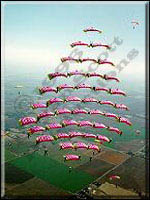Learning to fly with the crew dogs can be
strenuous work. I began shooting CReW for fun in 1984. In  the
beginning I wouldn't let anyone touch my parachute. As I slowly committed
myself to the activities in my area I developed an interest in making my
canopy do the things I had seen others canopy workers do. One of the first
things I discovered was that CReW formations change their flight characteristics
as they build. I found myself floating or overtaking the formations as
they were building. At the time I was working with photographer Mike Allen.
He knew I was interested in overcoming some of the basic flight mode problems.
Mike, like myself, had been wearing himself out trying to keep up with
the action. After making some jury rig modifications to my front risers
and consulting a qualified rigger the first leg assisted front riser trim
was born. This modification, with the experience it provided, has resulted
in the ability to change the glide slope and the forward speed of the canopy
at the same time. Remember, a canopy unencumbered, with no outside disturbances
to the airflow around it, will outperform any similar canopy in a formation.
A stack will sink more and more as the airflow is interrupted by bodies.
In addition the parachutes at the top of the stack will out perform the
bottom of the formation and the glide angle will grow stepper. A photographer's
canopy flown at the same glide slop will
the
beginning I wouldn't let anyone touch my parachute. As I slowly committed
myself to the activities in my area I developed an interest in making my
canopy do the things I had seen others canopy workers do. One of the first
things I discovered was that CReW formations change their flight characteristics
as they build. I found myself floating or overtaking the formations as
they were building. At the time I was working with photographer Mike Allen.
He knew I was interested in overcoming some of the basic flight mode problems.
Mike, like myself, had been wearing himself out trying to keep up with
the action. After making some jury rig modifications to my front risers
and consulting a qualified rigger the first leg assisted front riser trim
was born. This modification, with the experience it provided, has resulted
in the ability to change the glide slope and the forward speed of the canopy
at the same time. Remember, a canopy unencumbered, with no outside disturbances
to the airflow around it, will outperform any similar canopy in a formation.
A stack will sink more and more as the airflow is interrupted by bodies.
In addition the parachutes at the top of the stack will out perform the
bottom of the formation and the glide angle will grow stepper. A photographer's
canopy flown at the same glide slop will

 overtake
that stack. His airfoil will out perform the other parachutes. Other formations
can produce less airfoil turbulence and will seem to float, in comparison
to the a canopy stack. As formations build horizontally, the canopies retain
more of their original aerodynamics. This translates into a better glide
performance and less sink than that of the stack. What this means to the
photographer is that with every different formation, a distinct flight
mode must be mimicked in order to fly stationary in relation to your subjects.
overtake
that stack. His airfoil will out perform the other parachutes. Other formations
can produce less airfoil turbulence and will seem to float, in comparison
to the a canopy stack. As formations build horizontally, the canopies retain
more of their original aerodynamics. This translates into a better glide
performance and less sink than that of the stack. What this means to the
photographer is that with every different formation, a distinct flight
mode must be mimicked in order to fly stationary in relation to your subjects.
(Caution the following is an experimental
design. Death or injury can result.)
Presently I am working with a 4 point control system.
This involves both front risers and both brake toggles. The front risers
are connected by bail shackles to a long cross connector. This cross connector,
measured from its attachment points, falls approximately below the knees.
I built a pocket to stow excess line (stowage envelope). The line I prefer
is 1/2 inch tubular. For most applications I fly a PD 253, seven cell canopy
and load it with body weight and gear at 230 lb. I use long CReW brake
attachments so I have no problem maintaining a grip on the front risers.
No system is completely fool proof. Special attention must be given to your packing. If you are familiar with CReW in the late 80's, you'll remember we all use to fly 2 foot long front riser cross connectors. These were soon abandoned after discovering in some instances they could become lodged under the reserve, producing a nasty malfunction. The possibility for a hang-up exists now, except the cross connector is approximately 9 feet long and plays out of it's pocket before creating havoc. To prevent any chance of mishap it is suggested you put an extra 6 inches (of cross connector) into the top of the main container when packing. At this time you should also check the stowage envelope, making sure the Velcro securely holds the remainder of your cross connector webbing.
The proper deployment of this system will affect its performance and reliability. When exiting for a CReW load you will most likely be first out. The proper deployment for your front riser assist system is a flat stable exit. Good body position and an on-heading opening, should already be your first priorities. (Build and use this at your own risk. Mishaps and malfunctions with you main parachute and container can result.)
A good exercise to try: Find a partner wanting to do some two-way. Plan this dive as a no contact dive. Exit separately, approach your target without making contact. Fly end cell to end cell. It can be a challenge to fly from right end-cell to left then rotate below and practice docking on his foot with each of your end cells.
Any Drop Zone (DZ) interested in hosting a Mike Lewis CReW seminar
please E-Mail Mike.
![]()
